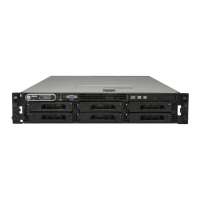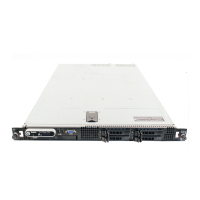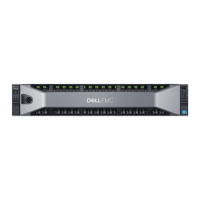5-14 Dell PowerEdge 4100/180 and 4100/200 Systems User’s Guide
To delete or change an existing supervisor or user pass-
word, you must know the supervisor password. See
“Deleting an Existing User Password” or “Deleting an
Existing Supervisor Password” found later in this section
for more information.
NOTE: A user password can only be assigned after a
supervisor password has been assigned.
If you assign and then forget a password, a trained service
technician must remove the cover of the computer (which
may require unlocking the computer’s keylock) and
change a jumper setting to temporarily disable the pass-
word features (see Appendix C, “Jumpers and Switches,”
in the Installation and Troubleshooting Guide).
Assigning or Changing a Supervisor
Password
Your system is shipped to you with the SUPERVISOR
PASSWORD category set to NOT ENABLED. Use the follow-
ing procedure to assign or change a supervisor password.
NOTE: To quit the following procedure without assigning
or changing a password, press the <ESC> key at any time.
1. Start the EISA Configuration Utility as described
in “Starting the EISA Configuration Utility”
found earlier in this chapter.
2. At the Main Menu, select CONFIGURE COMPUTER.
The system prompts you for a supervisor password if
one has been assigned. If prompted, type the pass-
word and press <ENTER>.
3. At the Steps in Configuring Your Computer
menu, select STEP 3: VIEW OR EDIT DETAILS.
The current status of the system board options
appears on the screen.
NOTE: If the SUPERVISOR PASSWORD category indi-
cates DISABLED BY JUMPER, a technician must install
the password jumper before you can assign a supervisor
password. See “Disabling a Forgotten Password” in
Appendix C of the Installation and Troubleshooting
Guide for instructions.
4. Select the SUPERVISOR PASSWORD category.
A dialog box with an Enter supervisor
password prompt and an empty seven-character
field appears on the screen.
5. Type your new supervisor password.
NOTE: The supervisor password can be the same as
the user password.
You can use up to seven characters; character keys or
blank spaces are acceptable.
To erase a character in your password, press the
<BACKSPACE> key.
NOTES: The supervisor password feature recognizes
keys without distinguishing between shifted and
unshifted characters or uppercase and lowercase let-
ters. For example, if you have an M in your password,
the system recognizes either M or m as correct.
Certain key combinations are not valid. If you enter
one of these combinations, the computer’s speaker
beeps.
6. Press <ENTER>.
A new dialog box with a Verify supervisor
password prompt and an empty seven-character
field appears on the screen.
CAUTION: If you leave your system running and
unattended, anyone can access the data stored in
your system even with a password assigned. To
protect your system while it is running, you must
use additional forms of protection, such as screen-
saver software protected by a password.
CAUTION: With the password features disabled,
your system operates as if it did not contain pass-
word features. If you leave your system running
and unattended without having a supervisor and/
or user password assigned or with the password
features disabled, anyone can assign a supervisor
and/or user password that will be unknown to
you.

